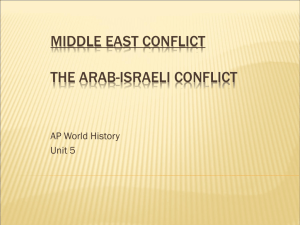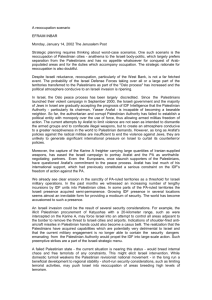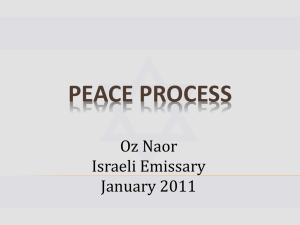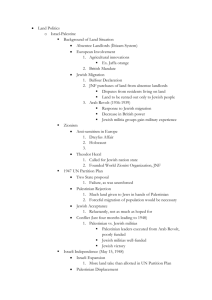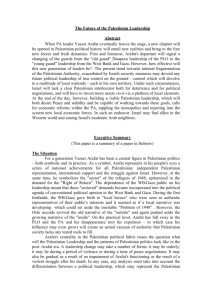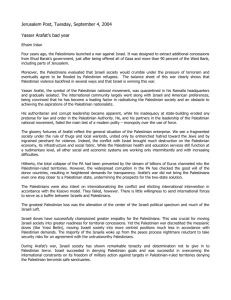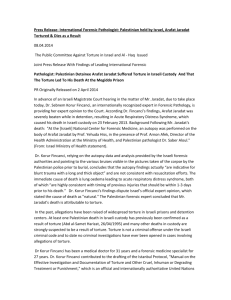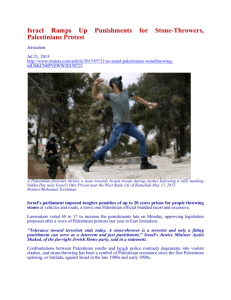Yasser Arafat - Media Watch International
advertisement
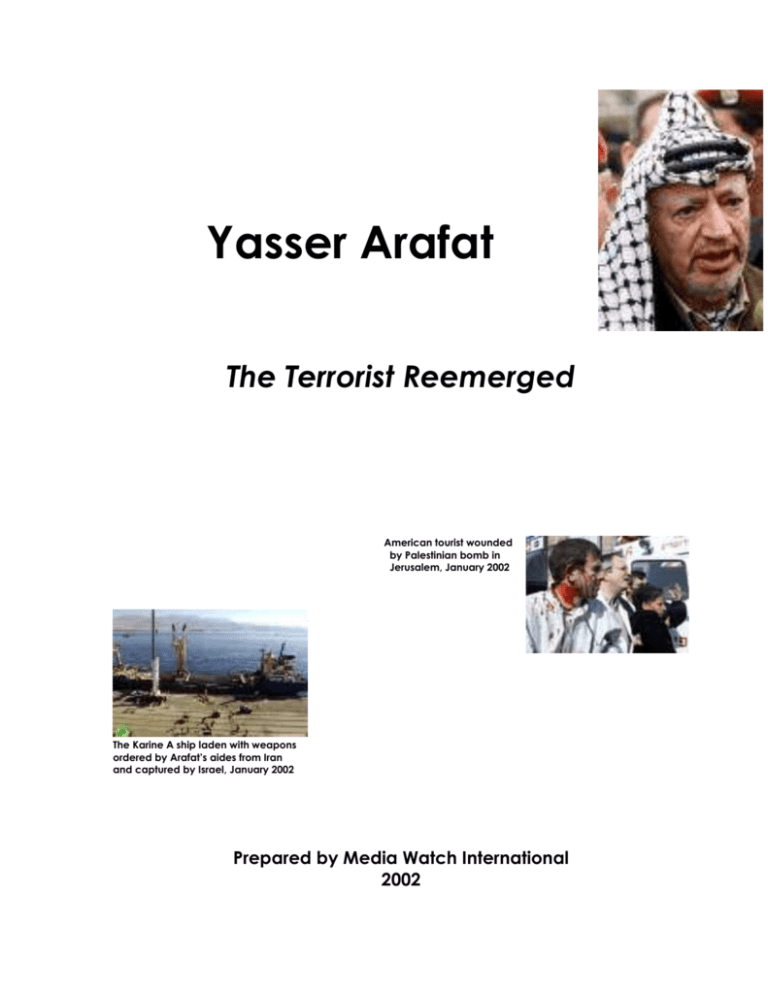
Yasser Arafat The Terrorist Reemerged American tourist wounded by Palestinian bomb in Jerusalem, January 2002 The “Karine A ship” laden with The Karine A ship laden with weapons ordered by Arafat’s aides from Iran and captured by Israel, January 2002 Prepared by Media Watch International 2002 Introduction The Hope 1993: When Prime Minister Yitzchak Rabin shook Yasser Arafat’s hand at the White House on September 13, 1993, a new era in the history of the Middle East conflict appeared to be dawning. A Declaration of Principles was signed. On May 4, 1994, Arafat and Rabin signed the Cairo Agreement, and Israel began the withdrawal from Gaza and Jericho. The Reality: Less than one week later, on May 10, 1994, Arafat declared in a Johannesburg mosque: “The jihad [Islamic holy war] will continue, and Jerusalem is not [only] for the Palestinian people, it is for all the Muslim nation... Now after this agreement…our main battle is Jerusalem. Jerusalem. The first shrine of the Moslems.” Following the Oslo Accords, Israelis and Americans alike shared the hope that Yasser Arafat, who headed the Fatah terror organization before Israel controlled the West Bank and Gaza and took over as Palestine Liberation Organization (PLO) chairman in 1968 vowing to destroy the Jewish state, had at last turned the corner and would lead the Palestinian people to accept Israel and make peace with the Jewish state. Instead, Arafat began to violate his agreements with Israel and the United States almost immediately just as he had violated every other agreement he had ever concluded, including those with Arab leaders. The section on Arafat’s pattern of deception and death underscores Jordan’s late King Hussein’s apt reported characterization, namely that Arafat “never came to a bridge he didn’t doublecross.” The purpose of this paper is to document Arafat’s reversion to form, revealing the wolf that, for a short period only, masqueraded in sheep’s clothing. It demonstrates that since the 1993 Oslo Accords--as he had for the preceding decades--Arafat continued to sponsor terrorism, pursue anti-American policies, foment hatred of Israel and Jews and intimidate foreign journalists. This paper also highlights the pervasive corruption within the Arafat-headed Palestinian Authority (PA), foreclosing any opportunity for the vast majority of Palestinians in the West Bank and Gaza to reap peace dividends. Each section is divided into a selected sampling of post-Oslo and pre-Oslo examples. Arafat’s Pattern of Deception POST-OSLO: Since Arafat’s arrival in Gaza and the West Bank, he has consistently ignored or reneged on the commitments he signed in the Oslo Accords, the Declaration of Principles (September 13, 1993), the Gaza-Jericho Agreement (Cairo, May 4, 1994), the Interim Agreement (Washington, D.C., September 28, 1995), the Wye River Memorandum (October 23, 1998), and the Sharm el-Sheikh Memorandum (September 4, 1999). The violations include: Direct use of violence Failure to resolve differences through negotiations Complicity in acts of terrorism Cooperation with Hamas and Islamic Jihad terrorist organizations Failure to collect illegal weapons Organized weapons smuggling Incitement, perpetuation of hatred and anti-Semitism Increasing Palestinian Police force beyond agreed numbers Releasing terrorists from jail Security organizations operating outside agreed areas Breaches of the agreed practice at the Gaza (Dahaniyah) Airport 2 Conducting foreign relations not permitted under the accords Criminal activity under PA auspices Failure to protect holy places These violations are entirely consistent with the PA’s stated policy as expressed in January 1996 by Nabil Sha’ath, one of Arafat’s senior ministers, who told a forum in Nablus that the Palestinians had little intention of meeting their commitments: We decided to liberate our homeland step-by-step… Should Israel continue -- no problem. And so, we honor the peace treaties and non-violence… if and when Israel says ‘enough,’ namely, we will not discuss Jerusalem, we will not return refugees, we will not dismantle settlements, we will not withdraw to the borders [i.e. those of June 4 1967]”, in that case it is saying that we will return to violence. But this time it will be with 30,000 armed Palestinian soldiers and in a land with elements of freedom… If we reach a dead end we will go back to our war and struggle like we did 40 years ago. PRE-OSLO: In 1968, when Arafat took over the PLO, he immediately set out to destroy the Hashemite Kingdom of Jordan and King Hussein. Along the way, he signed numerous diplomatic agreements, but honored none. After the 1967 war, the PLO established its headquarters and bases in Jordan. Attempts by King Hussein to disarm the PLO led to battles in November 1968. Again in the first half of 1970, King Hussein’s troops and PLO terrorists clashed. In June 1970, Arafat and the Jordanian prime minister signed an agreement under which Arafat committed to withdraw armed personnel from the Jordanian capital and respect law and order. Arafat broke his commitment. Clashes continued throughout the summer of 1970. By early September, Arafat and the PLO controlled several strategic positions in Jordan, including the oil refinery near Zarqa. Meanwhile, Arafat called for a general strike by all Jordanians. At the urging of the Arab heads of state, Hussein and Arafat signed a cease-fire agreement in Cairo on September 27. The agreement called for the rapid withdrawal of Arafat’s forces from Jordanian cities to locations "appropriate" for continuing the battle with Israel. Arafat broke his commitment. On October 13, 1970, King Hussein and Arafat signed another agreement in Amman, under which Arafat and the PLO would recognize Jordanian sovereignty and King Hussein's authority, withdraw their armed forces from towns and refrain from bearing arms outside their camps. Despite the September and October 1970 agreements, fighting continued, particularly in Amman, Irbid, and Jarash, where Arafat’s forces had their main bases. Arafat had broken his commitment again. Fighting continued through the summer of 1971, with Arafat breaking further agreements. Under constant pressure, Arafat finally pulled his forces from Amman in April 1971, but continued to assault King Hussein’s authority. Finally, on July 19, 1971, the Jordanian government announced that the last PLO bases in Jordan had been destroyed. Arafat and his commanders transferred their base of operation to Lebanon, where they would wreak havoc on Lebanon’s stability for the next decade. 3 King Hussein reportedly said of Arafat, “He never came to a bridge he didn’t doublecross.” Arafat’s Sponsorship of Terrorism POST-OSLO: Since arriving in Gaza and the West Bank in 1994, Arafat and his top aides have been involved in terrorism, systematically violating international law and signed commitments. Terrorism – Arafat and the PA have harbored the terrorists, including suicide bombers and gunmen, who had targeted Israeli civilians on buses, in shopping malls and market places and on the street. Under pressure from the United States, the PA arrested some of the bombers and bomb makers, often members of the terrorist groups, Hamas and the Islamic Jihad. These terrorists usually are released from jail within weeks. Arafat’s forces have been directly responsible for terrorist attacks on Israeli civilians: Palestinian children run with fake explosives dressed as Hamas suicide bombers. May 2001 (Reuters) The Tanzim, a paramilitary branch of Arafat’s Fatah, staged many attacks against Israeli motorists and Jewish neighborhoods in Jerusalem. Sometimes affiliations are blurred. For example, a Tanzim terrorist who was shot after killing two Israeli soldiers near Kfar Darom on November 20, 2000, was buried with Tanzim honors, but was then given a posthumous promotion by Arafat’s trusted deputy, Preventive Security Chief Mohammed Dahlan. Arafat’s own Presidential Guard, Force 17, is responsible for scores of roadside ambushes around Ramallah and Jerusalem and for an attack on a Social Security office in Jerusalem. The head of Force 17 in Ramallah is Mahmud Dhamra. Palestinian Naval Police from Iand-locked Tulkarm were responsible for a road-side bomb planted in Netanya on March 28, 2001. An agent of Musa Arafat’s Military Intelligence Organization in Nablus detonated a pipe bomb on a bus in Tel Aviv. Mortar factories have been set up in Gaza to produce long-range 120 mm aluminum mortars. Ghazi Jabali, Arafat’s chief of police, is in charge of the weapons manufacture. Alliance with terror organizations – Arafat and the Palestinian Authority have enhanced ties to Hamas, Hizbullah, Islamic Jihad and Iran. Hamas leader, Sheikh Ahmed Yassin, stated on April 2, 2001, “Today the situation is much better. The resistance is legitimate, and the Palestinian Authority closes its eyes and does not pursue the mujahidin.” Since the beginning of 2001, the PA forged new ties with the Iranian-backed Hizbullah terrorist organization in Lebanon culminating in the shipment of 50 tons of Iranian-provided weapons aboard the Karine A, reportedly brokered by Hizbullah. 4 Arms smuggling – Arafat embarked on an extensive arms smuggling campaign by land, sea and air, in contravention to international law and agreements he signed with Israel and the United States. The weapons include katyusha rockets, mortars, anti-aircraft missiles and rocket-propelled grenades. Cross border attacks – Arafat’s own forces in Gaza and the West Bank, including his presidential guard, Force 17, have taken part in hundreds of sniper attacks and mortar barrages against Israeli civilians. Exploiting children as combatants -- Arafat and the PA instituted a virulent anti-Israel curriculum for the PA’s school system, contravening signed agreements with Israel and the United States. Similarly, the PA’s official media – print, radio and television – promote violence against Jews and Israel. As a result, Palestinian children are primed and ready to riot and attack Israeli soldiers. According to the New York Times, the PA trained 25,000 children in weapons use.1 USA Today reported, “Children serve as infantry in the confrontations between Israeli and Palestinian soldiers. In scenes reminiscent of Iranian children sent to the Iraqi front equipped with plastic keys to heaven, Palestinian children are sent close to Israeli positions with rocks and Molotov cocktails, while the gunmen and snipers fire from positions hundreds of yards back.” 2 PRE-OSLO: During the 1970s and 1980s, Yasser Arafat and his PLO violated all standards of international law. They were directly implicated in – International terrorism Hijacking of aircraft and ships Hostage-taking Undermining sovereign governments Cross border attacks Mass murder Indiscriminate bombings Drug smuggling Promotion of terrorism and training terrorists Weapons smuggling Endangerment of civilian populations by placement of military facilities near schools and hospitals Use of children as combatants Arafat forged alliances with some of the world’s most destructive and dangerous terrorist gangs, including the Japanese Red Army, the Irish Republican Army, the Basque ETA, the Italian Red Brigades, the German Baader Meinhoff-Red Army Faction, Nicaraguan Sandinistas, and others. In the late 1960s and early 1970, Arafat and the PLO grew into a potent force and threatened to overthrow King Hussein of Jordan. As described by author David Pryce-Jones, “Arafat’s power challenge threatened to replace King Hussein with a PLO state in Jordan. The more protestations of friendship were made by Arafat, the more cast-iron agreements he signed to limit the scope of the PLO, the less the PLO in fact respected the law in Jordan.” 3 After a bloody civil war in 1970 and 1971, King Hussein expelled Arafat and the PLO, and they transplanted themselves to Lebanon. “Lebanon was unprepared to be the terrain where the New York Times, August 2, 2000 USA Today, October 23, 2000 3 The Closed Circle, Pryce-Jones, page 290. 1 2 5 PLO power challenge would reach its lethal culmination,” according to Pryce-Jones. “In an initial period, the eruption… of an armed PLO presence was met by compromise and signed agreements. It was not in the careerist nature of the PLO to respect these…” 4 In order to provide cover from direct involvement in terrorist planning and attacks, Arafat established a front organization, Black September, which carried out some of the bloodiest terrorist attacks ever seen. It became clear to western intelligence agencies, however, that Black September was part and parcel of Arafat’s terrorist apparatus. Arafat’s Anti-Americanism POST-OSLO: Despite the fact that, since 1993, USAID has provided $1 billion to help Palestinians living in the West Bank and Gaza, Arafat continues to maintain close ties to avowed enemies of the United States, including Iraq’s Saddam Hussein and Iran’s leadership. In recent months, Iranian-backed Hizbullah provided weapons and personnel to Arafat’s security services. The Karine A ship, loaded with 50 tons of Iranian weapons and destined for Arafat’s forces, was intercepted by Israeli troops in early January 2002. Arafat also permits his spokesmen and religious leadership to foment anti-American sentiment. It is not surprising then that demonstrations in the West Bank and Gaza frequently feature Hizbullah banners and the burning of Israeli and American flags. In the aftermath of the September 11, 2001, attack on the World Trade Center, “hundreds of Palestinians turned out to exult, seeing the attack as justified for U.S. support of Israel. Some fired rifles into the air, others offered candy to passers-by, a traditional gesture of celebration,” the Washington Post reported. Palestinian schoolgirls in Ramallah paint murals of American and Israeli flags with the Nazi swastika. (Reuters) Mustafa, a 24-year-old Palestinian gunman, told Reuters, "I feel I am in a dream. I never believed that one day the United States would come to pay a price for its support to Israel." In an October 2000 broadcast on the Palestinian Authority Television, Dr. Ahmad Abu Halabiya’s sermon included the following anti-American and anti-Semitic exhortations: "Have no mercy on the Jews, no matter where they are, in any country. Fight them, wherever you are. Wherever you meet them, kill them. Wherever you are, kill those Jews and those Americans who are like them - and those who stand by them - they are all in one trench, against the Arabs and the Muslims - because they established Israel here, in the beating heart of the Arab world, in Palestine. They created it to be the outpost of their civilization and the vanguard of their army, and to be the sword of the West and the crusaders, hanging over the necks of the monotheists, the Muslims in these lands. They wanted the Jews to be their spearhead.” 4 A Palestinian woman receives free sweets from a vendor as groups of locals in east Jerusalem's Old City celebrate after hearing the news of a terrorist attack on the World Trade Center in New York. (AP) Ibid 6 The U.S. State Department’s Coordinator for Counterterrorism annual report, released in April 2001, referred to ties between Osama bin Laden’s terrorist network and areas controlled by Arafat: “In late summer, Israeli authorities arrested Nabil Awkil, a militant they suspect has links to Hamas and Osama bin Laden. Israeli officials claim that Awkil underwent terrorist training in Bin Laden-affiliated camps in Afghanistan before returning to the West Bank and Gaza to establish terrorist cells.”5 PRE-OSLO: Arafat was implicated in the murder of American diplomats. In March 1973, eight Fatah terrorists kidnapped and murdered the U.S. ambassador to Sudan, Cleo Noel, and two other diplomats. According to press accounts, "Arafat, leader of Fatah, was in the Black September radio command center in Beirut when the message to execute three Western diplomats being held in Khartoum was sent... [Arafat] personally congratulated the guerrillas after the execution of the three diplomats... The CIA monitored at least some of the communications between the Beirut command center and the Saudi Arabian embassy in Khartoum, where the hostages were being held. Arafat's voice was reportedly monitored and recorded." (The Washington Post, April 5, 1973). Arafat directed the PLO into a firm embrace with the Soviet Union and its anti-American agenda. PLO commanders were trained in Soviet military camps. In 1979, Zehdi Terzi, the PLO representative at the United Nations boasted, “The Soviet Union and all the socialist countries… give us full support – diplomatic, moral, educational, and also they open their military academies to some of our freedom fighters.” The PLO trained other terrorist movements in the 1970s and 1980s in Nicaragua, Angola, El Salvador, and Iran. The PLO was implicated in weapons smuggling or training for terrorist groups in Ireland, France, Germany, Italy, Japan, Spain, and Latin America. Ayatollah Khomeini’s regime rewarded the PLO for its assistance in overthrowing the Shah in 1979 by turning over the Israeli embassy in Teheran to Arafat. Yasser Arafat and Iraq’s Saddam Hussein have a long history of cooperation. There is extensive evidence of PLO assistance to Iraq in the infiltration and invasion of Kuwait in August 1990.6 During the Gulf War, Arafat expressed his support for Iraq and Saddam Hussein on numerous occasions. On February 1, 1991, Arafat was quoted by UPI, “There is no choice for the PLO but to oppose the [American-sponsored] Allied force, because it is in the alliance with Israel. Anyone responsible for shedding the blood of Iraqis will be punished.” Arafat’s Anti-Israel and Anti-Semitic Incitement POST-OSLO: In recent years, Arafat repeatedly calls for jihad, or holy war, against Israel. AntiIsrael and anti-Semitic incitement in the Palestinian press and curricula undoubtedly played a role in the Palestinian attacks against Rachel’s Tomb in Bethlehem and the desecration of Joseph’s Tomb in Nablus and the “Peace on Israel” Synagogue in Jericho during the 2000-2002 fighting. 5 6 http://www.state.gov/s/ct/rls/pgtrpt/2000/index.cfm?docid=2438 Near East Report, May 21, 1991 7 On August 4, 1999, at a 70th birthday celebration, Arafat declared: "Some day soon, our children will be able to fly the Palestinian flag from the mosques and churches of Jerusalem. Allah willing, we will continue with our struggle, our jihad."7 Arafat frequently resorts to antiSemitic libels. In a speech at the Davos economic conference on May 20, 2001, he asserted, “Israel buried their radioactive toxic waste in our lands, used depleted uranium ammunition against our civilians, in addition to poisonous gases.” Upon taking office in Gaza and the West Bank, Arafat appointed a new mufti of Jerusalem, Sheikh Ikrima Sabri. In an October 2000 interview Palestinian mobs, led by Palestinian police, destroy Joseph’s Tomb in the Egyptian weekly, Al-Ahram Alin Nablus. (AFP) Arabi, Sabri expressed his attitude toward Jews in this way, "I enter the “As Palestinian troops stood by, some shooting in the air to express mosque of Al-Aqsa with my head up their own the joy, hundreds of Palestinian men set upon the shrine and at the same time I am filled with with pick axes and crowbars while black smoke billowed from the rage toward the Jews. I have never charred structure. Raising a Palestinian flag, the Palestinians said greeted a Jew when I came near that they were destroying Joseph's Tomb to ensure that the Israelis one. I never will. They cannot even never returned.” dream that I will. The Jews do not -- New York Times, October 7, 2000 dare to bother me, because they are the most cowardly creatures Allah has ever created..." 8 In November 11, 1999, Arafat’s wife, Suha, viciously attacked Israel in a prepared speech delivered before visiting American First Lady Hillary Clinton: "For years, our people have been subjected to a daily, intensive use of poison gas by the Israeli forces, which has led to an increase in cancer and other horrible diseases among women and children ... Israel has chemically contaminated about 80 percent of water sources used by Palestinians." Arafat denies Jewish rights to holy sites in the holy land, in Jerusalem or elsewhere. The following is typical Arafat fare: “Abraham was neither Jewish nor a Hebrew, but was simply an Iraqi. The Jews have no right to claim part of the Tomb of the Patriarchs in Hebron, Abraham's resting place, as a synagogue. Rather, the whole building should be a mosque." 9 “That is not the Western Wall at all, but a Moslem shrine." 10 PRE-OSLO: Arafat’s anti-Semitism also featured prominently before Oslo. He blasted Jews on January 30, 1992 according to a CNN transcript: “The Jews at work! Damn their fathers! The Jerusalem Post, August 5, 1999 Al-Ahram Al-Arabi (Egypt), October 28, 2000. 9 Jerusalem Report, Dec. 26, 1996 10 Ma'ariv, October 11, 1996 7 8 8 Dogs! Filth and dirt!… And thanks to the rotten Jews with whom I will settle accounts in the future.” Arafat’s Intimidation of Foreign Journalists POST-OSLO: The horrific murder of Wall Street Journal reporter Daniel Pearl in Pakistan has highlighted the life-threatening intimidation facing journalists reporting from countries harboring anti-American and anti-Semitic terrorists of all stripes, including Islamic terrorists. Thus, for example, journalists covering Palestinian celebrations of the September 11, 2001, attack s on the World Trade Center and the Pentagon were threatened not to film or photograph, provoking the following protest from the US-based Committee to Protect Journalists in a letter to Arafat: On September 11, according to international press reports, Palestinian police and armed gunmen prevented several news photographers and cameramen from documenting events in the West Bank city of Nablus, where groups of Palestinians celebrated the attacks by honking horns and firing live ammunition rounds into the air. According to the Associated Press, Palestinian security authorities summoned a freelance cameraman working for the AP that same day and warned him not to air his footage of the events. Members of the Tanzim militia, affiliated with Your Excellency's Fatah organization, also issued warnings that the AP cameraman interpreted as threatening. On September 14, Palestinian police briefly detained several photographers and cameramen working with international news agencies in the Gaza Strip and confiscated their equipment. The journalists had been covering a rally to commemorate a Palestinian suicide bomber that the militant Islamic group Hamas staged in the Nusseirat refugee camp. During the rally, one protester reportedly held up a portrait of Osama bin Laden.11 Jean Pierre Martin, a correspondent for Belgium’s RTL-TV1 reported on his team’s experience in October 2000 around Ramallah: We were filming the beginning of the demonstration. Suddenly, a van pulled in hurriedly. Inside, there were Fatah militants. They gave their orders and even distributed Molotov cocktails. We were filming. But these images, you will never see. In a few seconds, all those youngsters surrounded us, threatened us, and then took us away to the police station. There, we identified ourselves but we were compelled to delete the controversial pictures. The Palestinian Police calmed the situation but censored our pictures. We now have the proof that those riots are no longer spontaneous. All the orders came from the Palestinian hierarchy.12 Indeed, PA intimidation pays off, as illustrated by the pains taken by RTI, the official Italian TV network, to disassociate from the shocking footage of the October 2000 lynch of two noncombatant Israeli reservists by a Palestinian mob in Ramallah, aired by a competing Italian Jerusalem Post, September 24, 2001 Report filed by Jean Pierre Martin on October 5, 2000, a day after his Belgian television team from RTL-TV1 was filming around Ramallah. 11 12 9 news agency and picked up by all the international networks. RTI placed the following advertisement in the PA's main newspaper, Al Hayat-Al-Jadidah: My dear friends in Palestine. We congratulate you and think that it is our duty to put you in the picture of what happened on October 12 in Ramallah. One of the private television stations which competes with us (and not the official Italian television station RTI) filmed the events; that station filmed the events. Afterwards Israeli Television broadcast the pictures, as taken from one of the Italian stations, and thus the public impression was created as if we (RTI) took these pictures. We emphasize to all of you that the events did not happen this way, because we always respect (will continue to respect) the journalistic procedures with the Palestinian Authority for (journalistic) work in Palestine and we are credible in our precise work. We thank you for your trust, and you can be sure that this is not our way of acting (note: meaning we do not work like the other television stations). We do not (and will not) do such a thing. Please accept our blessings. Ricardo Christiano Representative of the official Italian station in Palestine13 Veteran Israeli Arab journalist Youssef Samir, 63, was abducted and held for 64 days by the PA's General Intelligence Service headed by Tawfik Tirawi and Amin al-Hindi. "I was given a mattress in one room of an office in the civil administration headquarters, where I was repeatedly beaten, humiliated, and terrorized," Samir told the Jerusalem Post following his June 7, 2001, escape. "I knew that unless I escaped from there I would die." 14 Amnesty International Annual Report 2000, issued a strong indictment of Arafat’s regime: Since its establishment in 1994, the PA has progressively restricted the right to freedom of expression through a variety of means, including arrest and detention by various security forces … Many detainees have been held incommunicado and some have been subjected to torture or ill-treatment…. Those arrested are rarely shown an arrest warrant or informed of the reason for their arrest. Nevertheless the fact that their arrest took place hours or days after they delivered a controversial speech or wrote a critical article, for example, leaves little room for doubt as to the reason for their detention. Critics of the PA may find themselves invited to have a short meeting over a cup of coffee with one or other of the security services, only for them to emerge from detention days, weeks, or even months later. Rarely has the PA brought anyone to court during their detention. Frequently, it was not clear to detainees which authority ordered their arrest, whether the initiative was taken by the security force detaining them or by another authority, such as the President [Arafat]. In many cases detainees were informed verbally that they were being held on “higher orders…:” Those arrested have included journalists, academics, political activists, lawyers, government officials, trade unionists, and religious figures. Many human rights 13 14 Al Hayat-Al-Jadidah, October 16, 2001 Jerusalem Post, June 8, 2001 10 defenders were detained in the early years…The PA has infringed the right to freedom of expression in other ways. Many journalists have reported being subjected to illtreatment at the hands of the security forces while they were going about their duties…. Newspapers, research centers, news agencies, television and radio stations have all been closed for days or even weeks. In May and June 2000, two private radio stations in the West Bank…and three private television stations were closed by the Palestinian police for several days….15 PRE-OSLO: During the PLO’s six-year reign of terror in Lebanon (1976-1982), not only were Lebanese and foreign journalists who wrote articles critical of Arafat or the PLO harassed, in several cases the PLO murdered them. The victims of Arafat’s ultimate form of censorship include: Edouard Saeb, editor of L’Orient le Jour and Le Monde correspondent, assasinated by PLO gunmen, September 1976. Riadh Taha, president of the Lebanese publisher’s union. After meeting with Lebanese leader Bashir Gemayal to work out an anti-PLO front, Taha was murdered by PLO gunmen, 1980.16 Journalist Edouard George, who worked for Edouard Saeb, compiled a list of seven foreign journalists who were killed by Arafat’s PLO between 1976 and 1981: Larry Buchman, correspondent for ABC Television Mark Tryon, Free Belgium Radio Jean Lougeau, correspondent for French TF-1 Tony Italo, Italian journalist Graciella Difaco, Italian journalist Sean Toolan, correspondent for ABC Robert Pfeffer, correspondent for Der Spiegel17 The well-known Beirut Daily Star ceased publication in the 1980s. The editor explained, “We join those many of our readers who have been driven from this country by the kidnappers, murderers, car bombers and extortionists… [T]he gunmen have transformed Lebanon into a thugocracy ruled by two-legged wild beasts whose sole reason and law is the gun.” 18 Following the murder of Wall Street Journal reporter Daniel Pearl, the New York Time’s John Kifner reflected on the dangers confronting foreign correspondents throughout the Muslim world – including a night in spring 1982 (before the Lebanon War) that he spent in a Beirut dungeon along with many other journalists, imprisoned by Palestinian guerillas who did not want reporters to cover a certain story.19 http://www.web.amnesty.org/web/ar2000web.nsf/countries/7dae741e5b9afed580256 Eliyahu Tal, “Now the Story Can Be Told,” WZO publishing, 1982 17 Eliyahu Tal, ibid 18 The Closed Circle, by David Pryce-Jones, Harper: 1989, page 294. 19 New York Times, February 24, 2002 15 16 11 Arafat’s Corruption POST-OSLO: Instead of providing his people a peace dividend, improving their economic and living conditions, Arafat has diverted billions of dollars in foreign aid into private hands. According to BBC News: [The Palestinian Authority] has brought corruption, police brutality and - with an estimated 120 separate departments answering directly to Mr. Arafat - there has been very little movement towards the pluralist civil society that was envisaged. In 1997, a much-quoted Palestinian parliamentary committee report found that nearly 40% of the PA's $800m annual budget, much of it coming from foreign aid donations, had been squandered through corruption and mismanagement. 20 Arafat exploits his position as Palestinian Authority President to funnel hundreds of millions of dollars into personal accounts. The London Sunday Telegraph reported in 1999 that computer hackers entered the PLO’s computers and discovered that “Arafat has salted away billions of pounds for the Palestinian Liberation Organization in secret foreign bank accounts and investments, including property in London.” The article continued: “…The PLO maintains about £5 billion in numbered bank accounts in Zurich, Geneva and New York. It also holds accounts with smaller sums in North Africa, Europe and Asia. They are not registered in the PLO's name, but in the names of private individuals. The records also showed that the PLO owns shares on the Frankfurt, Paris and Tokyo stock exchanges, including stock in the German car giant Mercedes Benz, and property in prestigious areas of European capitals, including Mayfair in London. 21 In 1997, PBS Newshour aired “Rating Arafat’s Rule.” Reporter Margaret Warner found, “ The charges of mismanagement and corruption come from some legislative councilors. They say that while many ordinary Palestinians live in grinding poverty, international donor funds are being misappropriated to subsidize opulent homes for Arafat’s ministers and entourage.” She continued, “They also say some ministers demand a cut of the action in return for granting lucrative government contracts. Arafat appointed an auditor to look into the charges. Last weekend, the auditor announced that $326 million of public funds had been lost to corruption and mismanagement by the Palestinian Authority.” 22 The U.S. Government does not trust Arafat’s administration. Under the strict supervision of the U.S. Congress, no U.S. federal funds are granted to the Palestinian Authority. All funds are provided to non-governmental agencies (NGOs) and are subjected to strict accounting. Arafat’s regular benefactors, European and Arab countries, are also showing caution and reluctance to contribute more to Arafat because of the Palestinian Authority’s corruption. In March 2001, for instance, Chris Patten, the European Union’s commissioner for external affairs, warned that 60 million euros would not be delivered to the PA until the Europeans could see better accounting. "We made it clear to Mr. Arafat,” Patten said, “that in order for us to go on providing substantial assistance, we need to see a tough, realistic budget, we need to see BBC News, November 30, 2001 London Sunday Telegraph, December 5, 1999. 22 http://www.pbs.org/newshour/bb/middle_east/may97/arafat_5-28a.html, PBS, May 28, 1997. 20 21 12 greater transparency, we need to see a complete commitment to deal with corruption, and we need to see other donors contributing."23 PRE-OSLO: When the Israel Defense Forces drove Yasser Arafat and the PLO out of Beirut in 1982, they discovered that PLO operatives were involved in arms trafficking, narcotics trade, and money laundering.24 Palestinian workers throughout the Arab world contributed a tax to the PLO during the 1970s and 1980s. The money was deposited in bank accounts controlled by Arafat. According to the New York-based Center for the Study of Corruption and Rule of Law, “In 1990, the CIA estimated that the PLO had between $ 8 billion to $ 14 billion worth of assets generated from five percent tax on every Palestinian working in Arab countries…. According to a 1993 British National Criminal Intelligence Service (NCIS) report published on the eve of the famous "hand shake" on the White House lawn, most of the PLO's assets originated from "donations, extortion, payoffs, illegal arms dealing, drug trafficking, money laundering, fraud, etc.” 25 Independent, March 14, 2001 The Closed Circle, by David Pryce-Jones, Harper: 1989, page 303. 25 Washington Times, March 15, 2001 23 24 13 Appendix Arafat’s Commitments – Abandoned, Broken and Shattered The following compilation lists Arafat’s commitments to Israel and to the United States. Since the signing of the Oslo Accords, Arafat has rarely complied with the commitments. And since the beginning of the 2000 “Intifada” Arafat has abandoned virtually all of them. Combating Terror and Violence * Renunciation of the use of terrorism and other acts of violence (Arafat’s Letter to Rabin, September 9, 1993). * Recognition of the right of Israel to exist in peace and security (Arafat’s Letter to Rabin, September 9, 1993). * Commitment to the peaceful resolution of the conflict and that outstanding permanent status issues will be resolved through negotiations (Arafat’s Letter to Rabin, September 9, 1993). * Adoption of all necessary measures to prevent acts of terrorism, crime and hostilities and taking of legal measures against offenders(Gaza-Jericho Agreement, Article XVIII; Interim Agreement, Article XV). * Establishment of a strong police force in order to guarantee public order and internal security for Palestinians (Declaration of Principles, Article VIII; Gaza-Jericho Agreement, Article VIII; Annex I, Article III; Interim Agreement, Article XII, Article XIV). * The Palestinian Police will act systematically against all expressions of violence and terror (Interim Agreement, Annex I, Article II.1). * The Palestinian Police will arrest and prosecute individuals who are suspected of perpetrating acts of violence or terror (Interim Agreement, Annex I, Article II.1). * Immediate, efficient and effective handling of any incident involving a threat or act of violence or incitement (Interim Agreement, Annex I, Article II.2). * Apprehension, investigation and prosecution of those directly or indirectly involved in acts of terrorism, violence and incitement (Interim Agreement, Annex I, Article II.3). * Security arrangements concerning planning, building and zoning (Gaza-Jericho Agreement, Annex I, Article VI; Interim Agreement, Annex I, Article XII). * Reaffirmation of commitment to fight terror and violence (Note for the Record). * Reaffirmation of commitment to systematically and effectively combat terrorist organizations and infrastructure (Note for the Record). * Reaffirmation of commitment to apprehend, prosecute and punishment of terrorists (Note for the Record). * Recognition that it is in their vital interests to combat terrorism and fight violence (Wye River Memorandum, Article II). * Israeli-Palestinian cooperation to combat violence and terror (Wye River Memorandum, Article II). 14 * Comprehensive, continuous and long-term struggle against terror and violence with respect to terrorists, terror support structure and environment conducive to the support of terror (Wye River Memorandum, Article II). * Palestinian side will make known its policy of zero tolerance for terror and violence against both sides (Wye River Memorandum, Article II.A.1a). * Palestinian work plan to ensure the systematic and effective combat of terrorist organizations and their infrastructure (Wye River Memorandum, Article II.A.1b). * US-Palestinian committee to review the steps being taken to eliminate terrorist cells and terror support structure (Wye River Memorandum, Article II.A.1c). * Apprehension of individuals suspected of perpetrating acts of violence and terror and establishment of US-Palestinian committee to review such matter (Wye River Memorandum, Article II.A.1d,e). * Act to ensure immediate, efficient and effective handling of any incident involving a threat or act of terrorism, violence or incitement. Exchange of information and coordination of policies and activities in this regard (Sharm el-Sheikh Memorandum, Article 8.a). * Immediate and effective response to the occurrence or anticipated occurrence of an act of terrorism, violence or incitement and shall take all necessary measures to prevent such an occurrence (Sharm el-Sheikh Memorandum, Article 8.a). Prevention of Incitement * Abstention from incitement, including hostile propaganda and adoption of legal measures to prevent such incitement (Interim Agreement, Article XXII). * Non-introduction of motifs into educational systems (Interim Agreement, Article XXII). * Immediate, efficient and effective handling of any incident involving a threat or act of violence or incitement (Interim Agreement, Annex I, Article II.2). * Active prevention of incitement to violence (Interim Agreement, Annex I, Article II.3). * Apprehension, investigation and prosecution of those directly or indirectly involved in acts of terrorism, violence and incitement (Interim Agreement, Annex I, Article II.3). * Reaffirmation of commitment to prevent incitement and hostile propaganda (Note for the Record). * Issuance of a decree, comparable to existing Israeli legislation, prohibiting all forms of incitement to violence or terror and establishment of mechanisms for acting against all expressions or threats of violence or terror (Wye River Memorandum, Article II.A.3a). * Establishment of a US-Palestinian-Israeli committee to monitor cases of possible incitement to violence or terror and to make recommendations and reports on how to prevent such incitement (Wye River Memorandum, Article II.A.3b). * Immediate and effective response to the occurrence or anticipated occurrence of an act of terrorism, violence or incitement and shall take all necessary measures to prevent such an occurrence (Sharm el-Sheikh Memorandum, Article 8.a). Prohibition of Illegal Weapons * No manufacture, sale, acquisition, importation or introduction of any firearms, ammunition, weapons, explosives, gunpowder or related equipment into the West Bank or Gaza Strip, except for those of the Palestinian Police (Gaza-Jericho Agreement, Article IX.3; Interim Agreement, Article XIV). 15 * The Palestinian Police will prevent the manufacture of weapons as well as the transfer of weapons to persons not licensed to possess them (Interim Agreement, Annex I, Article XI.2). * Limitations on arms and ammunition for the Palestinian Police (Gaza-Jericho Agreement, Annex I, Article III.5, Interim Agreement, Annex I, Article IV; Hebron Protocol, Article 5). * Reaffirmation of commitment to confiscate illegal firearms (Note for the Record). * Ensuring an effective legal framework to criminalize any importation, manufacturing or unlicensed sale, acquisition or possession of firearms, ammunition or weapons in areas under Palestinian jurisdiction (Wye River Memorandum, Article II.A.2a). * Establishment and implementation of a systematic program for the collection and appropriate handling of illegal weapons etc. (Wye River Memorandum, Article II.A.2b). * Establishment of a US-Palestinian-Israeli committee to assist and enhance cooperation in preventing the smuggling or unauthorized introduction of weapons or explosive materials into Palestinian areas (Wye River Memorandum, Article II.A.2c). Continuation of the program for the collection of illegal weapons, including reports (Sharm elSheikh Memorandum, Article 8.b). * Security Cooperation with the Israeli Side * Establishment of Establishment of a Joint Security Coordination and Cooperation Committee and District Coordination Offices (Gaza-Jericho Agreement, Article VIII; Annex I, Article II; Interim Agreement, Article XII). * Establishment and operation of Joint Patrols and Joint Mobile Units (Gaza-Jericho Agreement, Annex I, Article II; Hebron Protocol, Article 4). * Establishment of Joint Aviation Committee and Maritime Coordination and Cooperation Center (Gaza-Jericho Agreement, Annex I, Article XI, XII; Interim Agreement, Annex I Articles XIII, XIV). * Arrest and transfer of individuals suspected of, charged with or convicted of an offense falling under Israeli criminal jurisdiction (Gaza-Jericho Agreement, Annex III, Article II.7; Interim Agreement, Annex IV, Article II.7). * Requests for arrest and transfer of individuals to be submitted to the Joint Legal Committee and respond to within a twelve-week period (Wye River Memorandum, Article II.B.3) * Full and comprehensive bilateral security cooperation (Wye River Memorandum, Article II.B.1). * Exchange of forensic expertise, training and assistance (Wye River Memorandum, Article II.B.2). * Establishment of high ranking US-Palestinian-Israeli committee to asses current threats, deal with impediments to effective security cooperation and address steps being taken to combat terror and terror organizations (Wye River Memorandum, Article II.B.3). * Undertaking to implement its responsibilities for security and security cooperation (Sharm elSheikh Memorandum, Article 8). 16
